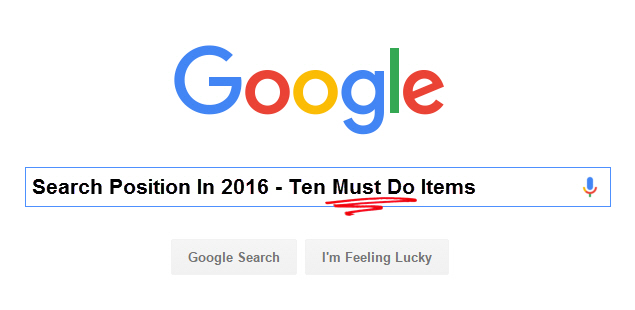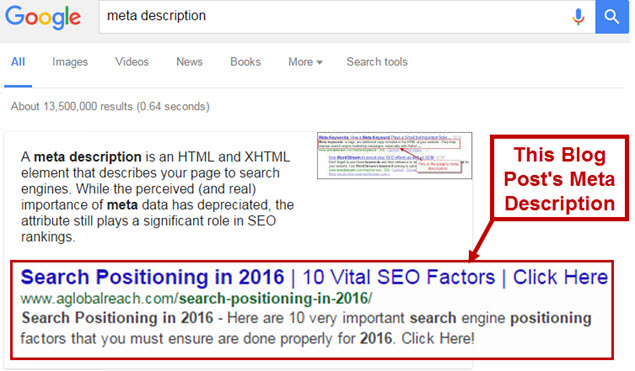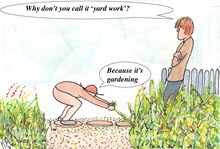Search Positioning in 2016
Search Positioning in 2016
Ten Things You Must Do

Here are 10 very important search engine positioning factors that you must ensure are done properly for 2016. Search algorithms are always being improved and now the emphasis is significantly on showing search results based on a pleasing and helpful user experience.
1. Create Outstanding Content
 Delightful content is essential. It is necessary to be a player. If your content is not interesting, useful and fun then do not even get into the competition for search position.
Delightful content is essential. It is necessary to be a player. If your content is not interesting, useful and fun then do not even get into the competition for search position.
Think about ways you solve the problems of your audience. Be fun and engaging! Share freely. Be helpful.
2. Improve Your Bounce Rate

The bounce rate is simply the ratio of the number of people who click to go to your webpage from Google and click the back button to go back to search results in contrast to the total number of visitors who visited 2 or more of your website’s pages. Stated another way, bounce rate is the number of one page visits versus two or more page visits to your website.
Why is this an important ranking factor? Google views the bounce rate as an indication of quality. If people do not stay on your website and return to Google to search again then Google can conclude that your page is not properly positioned (it is positioned too high) if a large number of searchers visit the page and then return to Google to search again.
If you bounce rate is over 55% (a number based on my experience) think of doing some content experiments to lower your bounce rate. I have seen pages improve in search position soon after this 55% goal is achieved.
3. Focus on the Visitor Experience
 Google is in a continuous mode to improve the search results it presents to searchers (its customers). As Google invested and improved it began to incorporate new metrics such as a user’s experience and website engagement into its ranking algorithm.
Google is in a continuous mode to improve the search results it presents to searchers (its customers). As Google invested and improved it began to incorporate new metrics such as a user’s experience and website engagement into its ranking algorithm.
It makes sense. If Google sends you to a web page, they want to make sure you have a good experience on that page. They are, after all, a business too, and Google needs to delight its customers. Think about it from the search engine’s point of view: they didn’t create the webpage themselves, but they are endorsing it. They need to ensure that users have a good experience on that page to keep people coming back to Google.
Google is always indicating to us which pages are creating a delightful user experience. These are the pages being presented high in the search results.
4. Use Google My Business
 If you are a local business then just having a website isn’t enough to rank well in Google’s local search listings. To rank well you need to set up and verify a Google+ Business Page or now called a Google My Business Page. To be displayed high in the local search results by Google treat your Google Business Page as you would your website, and optimize it.
If you are a local business then just having a website isn’t enough to rank well in Google’s local search listings. To rank well you need to set up and verify a Google+ Business Page or now called a Google My Business Page. To be displayed high in the local search results by Google treat your Google Business Page as you would your website, and optimize it.
If you want to be found based on a geographic location then optimizing for local search will help. It will help you to be found by people who are in need of your product or service that has a geographic aspect to it and people who are interested in your product or service and your geographic location are more likely to engage you.
Looking forward, Google will continue to take steps to bubble the best local content to the surface of search results. Need some proof? In July of 2014, Google took a major step in this direction with the release of its new Pigeon algorithm. The algorithm treats local search rankings more like traditional search rankings, taking hundreds of ranking signals into account. Pigeon also improved the way Google evaluates distance when determining rankings.
The bottom line: Local SEO matters and more now than in the past.
5. Fine Tune Your Meta Descriptions

Having a relevant, compelling meta description can be the difference between a searcher who clicks through to your page and one who clicks elsewhere. Therefore, if you have done all the hard work to get a top position and do not have a compelling meta description your work can be in vain and a low click-through rate after you have achieved a high position may result in you losing this coveted position. A low click through rate can have a very negative affect on your position in search.
Therefore, fine tune your meta descriptions!
Click through rate was a big factor in Google’s ranking algorithm according to Searchmetrics in 2015. It is likely to continue to be a big SEO ranking factor in 2016.
6. Create Content based on Semantics (meaning)
 Keywords do not need to be repeated exactly throughout a piece of content. In a headline, in particular, you want to use a keyword (or keywords) in a way that makes the most sense to your human audience. The goal should be to write a compelling and descriptive headline (somewhere between 4-9 words) that clearly explains what your content is about.
Keywords do not need to be repeated exactly throughout a piece of content. In a headline, in particular, you want to use a keyword (or keywords) in a way that makes the most sense to your human audience. The goal should be to write a compelling and descriptive headline (somewhere between 4-9 words) that clearly explains what your content is about.
Keyword stuffing is the act of shoving as many keywords into the page as possible. Google has been warning us not to do this for years. Write delightful content and do not worry (at all) about putting the keyword phrase you seek high position for throughout the page. Create delightful human-pleasing content and search position will take care of itself relative to this factor.
Google is no longer trying to match the keywords you type into its search engine to the keywords of a web page. Instead, it’s trying to understand the intent behind the keywords you type so it can match that intent to relevant, high-quality content.
7. Optimize Your Images
 For a long time, it was okay to neglect the images on your site and still rank without using alt text and image file names to boost your page relevance and position in search. On-page SEO is more important than ever, so excluding images from the SEO process will prevent your website’s SEO from being the best it can be.
For a long time, it was okay to neglect the images on your site and still rank without using alt text and image file names to boost your page relevance and position in search. On-page SEO is more important than ever, so excluding images from the SEO process will prevent your website’s SEO from being the best it can be.
If your competitors optimize their images then your site will be at a disadvantage. If a searcher puts Google into image search mode to find what they want and your products or services can be represented by images then you need to optimize your image content.
Name your image files something that is indicative of what the image is itself, rather than something like IMG12345.jpg. Yes, keywords matter here!
8. Be Kind to Mobile Visitors
 In the spring of 2015, Google had an algorithm update called “Mobilegeddon”,(isn’t that a great name!). This update put a larger emphasis on the mobile friendliness of a domain as a ranking signal. The update rewards mobile-friendly websites and penalizes those that aren’t fully optimized for mobile.
In the spring of 2015, Google had an algorithm update called “Mobilegeddon”,(isn’t that a great name!). This update put a larger emphasis on the mobile friendliness of a domain as a ranking signal. The update rewards mobile-friendly websites and penalizes those that aren’t fully optimized for mobile.
You need to create the optimal experience for your visitors. This helps to optimize your position in search. The best approach so that your search position is not affected is to implement responsive design. Responsive design makes your page “respond” to the visitor and will display information that is sized and zoomed appropriately so it’s easy to read on whatever device your valuable visitor is using.
9. Don’t Hand Your SEO Off to Your IT Department

Some management has the perception that SEO – being technical – can be done by IT. There is a technical component to SEO but to implement it properly requires significantly more than just technical expertise. SEO spans market research (including competitive analysis) to content creation and monitoring and adjusting. Think long and hard before handing your search position marketing to IT.
Though you may need some support from IT during the course of optimizing your website, it’s far from ideal to just give the SEO duties to IT and expect best practices to be adhered to.
While many IT professionals are adept in many technical areas — for instance, making sure your website is crawlable and setting up redirects and XML sitemap files. Please note that your IT personnel may also work on things like setting up printers, or making sure the anti-virus software is functioning properly which is a different skill set than what’s needed to effectively run an SEO strategy.
10. Blog
 Raise your hand if you want more website visitors. (Everyone always raises their hand).
Raise your hand if you want more website visitors. (Everyone always raises their hand).
Now think about the ways people find your website:
A) They could type your name right in to their browser, but that’s an audience you already have. This traffic already knows you. You will not increase your traffic from this source. You’re already getting this traffic. Note that blogging will help you to keep this traffic.
B) You could pay for traffic by buying an email list (don’t you dare!), blasting them, and hoping some people open and click through on the emails. But that’s expensive and beyond being expensive it is illegal.
C) You could pay for traffic by placing paid ads, which isn’t illegal, but still quite expensive. If you scale back your budget for paid ads your traffic will scale back too.
So, how can you drive traffic? In short: blogging, social media, and organic search engine positioning. Here’s how it works.
Think about how many pages there are on your website. Probably not all that many. Moreover, think about how often you update those pages. Probably not that often. (How often can you really update your About Us page anyway.)
Blogging helps solve all these problems.
Every time you write a blog post, it’s one more indexed page on your website, which means it’s one more opportunity for you to show up in search engines and drive traffic to your website in organic search.
It is also a way to lower your bounce rate and keep people on your site longer and blogging helps to create incoming links and gives you (and others) something to share on social media.
Blogging helps in other ways too!
Blogging . . .
- Provides a mechanism to project your authority into your marketplace.
- Forces you to become better as you need to research, analyze, think about and write.
- Is fun!
I hope you found these ten tips on how to help your search positioning in 2016 useful. If you think others you know may benefit from this article then feel free to share it using the sharing buttons below – thanks!
